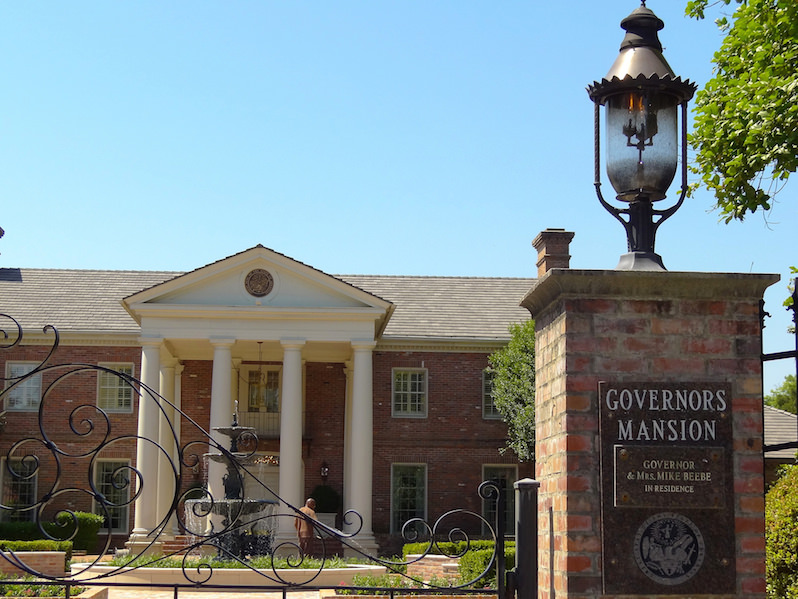At Least Seven States Have Prison Inmates Working in Governors’ Mansions and Capitol Buildings
The 13th Amendment provides a loophole that allows for the legality of unpaid prison labor, which is sometimes called "modern-day slavery." The Arkansas governor's mansion (pictured) uses unpaid prison labor. (Adam Jones / CC 2.0)
The Arkansas governor's mansion (pictured) uses unpaid prison labor. (Adam Jones / CC 2.0)
By Celisa Calacal / AlterNet
The Arkansas governor’s mansion (pictured) uses unpaid prison labor. (Adam Jones / CC 2.0)
When activist Sam Sinyangwe was awaiting a meeting with the governor’s office at the Louisiana state capitol building in Baton Rouge, he noticed something odd. A black man in a dark-blue jumpsuit was printing papers while a correctional guard—with a badge and gun—stood watching over him. The pair stood out against the white, middle-aged legislators populating the building.
Sinyangwe said he did not know exactly what he was looking at, until he saw another black man in the same dark-blue outfit serving food at the capitol building’s cafeteria. This time, Sinyangwe noticed that the man had a patch on his chest labeling him a prisoner of the Louisiana State Department of Corrections, complete with an identification number.
Sinyangwe realized that the server, the man printing papers and the other people working in the lunch line were all prisoners.
Inmates working at the capitol building in Baton Rouge is a common sight. Prisoners work in the Louisiana governor’s mansion and inmates clean up after Louisiana State University football games as well. But the labor practice of having inmates work in state government buildings extends beyond Louisiana; at least six other states in the U.S. allow for this practice: Arkansas, Alabama, Missouri, Oklahoma, Nebraska and Georgia.
The inmates allowed to work in the capitol or at the governor’s mansion are fairly low in number and are carefully screened. According to NOLA.com, about 20 to 25 people work daily in the capitol, and 15 to 18 other inmates work as groundskeepers outside the building. The inmates may not be serving a sentence for a sex crime or a violent offense like murder and must have a history of good behavior while incarcerated and display good work ethic. Furthermore, only inmates at the Dixon Correctional Institute (a men-only facility) can work at the capitol, as it is only 30 miles away.
A similar process occurs in Georgia, where inmates must receive a referral from the Board of Pardons of Parole or the Classification Committee within a state prison. Working at the governor’s mansion in Georgia is contingent upon an inmate’s criminal history, their behavior while incarcerated and their release date, among other factors.
The inmates perform janitorial tasks such as cleaning the floors or the offices of state legislators. In the Louisiana capitol, inmates also perform small tasks for legislators like grabbing lunch for them.
While inmates working in state government buildings are dutifully screened, they are not much better paid than prisoners with other jobs. In Louisiana, inmates in the capitol are paid between 2 and 20 cents per hour. They could opt for earning good-time credit toward early release, but only if they qualify. And with a normal workday of at least 12 hours—from 5 in the morning to at least 5 in the afternoon, barring legislative sessions when inmates work more than 12 hours—the prisoners make between 24 cents and $2.40 a day. Inmates working in the governor’s mansion in Missouri recently got a small pay raise to $1.25 an hour to make about $10 per day. With the previous arrangement, prisoners earned $9 a day. In Arkansas, the prisoners are not paid at all.
History of the practice
The practice of using prison inmates as laborers stretches back to the end of the Civil War and the Emancipation Proclamation. As more black people were freed from slavery, the plantation economy of the South began to falter with the loss of their primary form of labor. The result was the establishment of vagrancy laws, which specifically targeted black communities, in an effort to incarcerate more black people and force them to work once again.
Even the name given to prisoners who work as servants in governor’s mansions and capitol buildings in some states—trustee—is the same title that was given to prisoners who worked as overseers on infamous prison plantations such as Angola and Parchman. Prison plantations began replacing the convict lease system in the 1920s as a way for prisoners, an overwhelming majority of whom were black men, to work. Back then, it was considered a privilege to be an overseer on a plantation, and the same narrative goes for inmates working in governor’s mansions today.
“All of this, it looks very familiar: having black laborers toiling in the fields under the eye of overseers and having a white governor served by people drawn from that same forced labor pool,” said Carl Takei, a staff attorney at the National Prison Project of the ACLU.
Since then, prisoners have been used as underpaid and unpaid laborers, from private companies to state government buildings. The legal loophole that allows this practice to continue is the 13th Amendment to the Constitution. While the 13th Amendment is best known for abolishing slavery, a clause in the amendment stipulates for the continued legality of slavery within the criminal justice system.
The clause reads: “Neither slavery nor involuntary servitude, except as a punishment for crime whereof the party shall have been duly convicted, shall exist within the United States, or any place subject to their jurisdiction.”
“If somebody is being subjected to forced labor as part of their sentence in a criminal proceeding, then that is outside the scope of the 13th Amendment,” Takei said.
Modern-day slavery?
Hillary Clinton made waves for a passage in her 1996 book “It Takes A Village” when a Twitter user posted photos of a passage in the memoir where Clinton talks about the prisoners who worked in the governor’s mansion. The passage quickly spread through social media, with many people criticizing Clinton and calling the practice a form of modern-day slavery.
Both Sinyangwe and Takei agree that the current system is exploitative in that inmates who work are barely paid.
“When you lock people up and force them to work without providing them a fair wage, that’s called slavery,” Takei said.
Despite scrutiny from criminal justice advocates, many corrections departments in states that still use this practice have justified it on the grounds that having inmates work reduces recidivism rates and is more beneficial to them overall.
Joseph Nix, director of executive security at the governor’s mansion in Mississippi, told the Los Angeles Times in 1988 that the inmates “tend to make the best workers.”
George Lombardi, the Missouri Department of Corrections director, defended the department’s work release program, in which one of the jobs includes working at the governor’s mansion. About 700 of the 30,000 inmates in the state’s prison system are part of the work release program.
Lombardi told Missourinet the program “instills great work ethic, pride, self-esteem and compassion in offenders.”
“It really cuts to the core philosophy of our department, which is in addition to the time you have to serve, you have another obligation to help your community if possible,” Lombardi said. “So we present you with opportunities to do that in the form of work release and/or our restorative justice efforts that we have throughout the system.”
Paula Earls, executive director of the governor’s mansion in Missouri, told the Los Angeles Times in 1998 that there have been no problems with inmates and touted the benefits of having inmates work at the mansion.
“We’re their last leg before they get out to society,” she said. “I treat them like staff. I appreciate the work they do. They are ready to go back out and make something of themselves and we hope we help with that.”
Sinyangwe said these justifications for using inmate labor share similarities with the justifications people used for slavery—that it helped civilize black slaves and increased their work ethic.
“When you read the history books about the Antebellum South, those are the same arguments being used,” he said. “So I’m not persuaded by them. I don’t think they’re original or new.”
Arguments that inmate labor can prepare prisoners for integrating into the outside world once they are released also lose weight because of how difficult it is for former prisoners even to get a job to begin with. The hiring practice of asking applicants to indicate their criminal history on job applications has a harmful effect on ex-convicts, as they are less likely to get called back. These results skew along racial lines, as a study by Harvard sociologist Devah Pager found that only 5 percent of black men with a criminal conviction hear back from potential employers. The research also showed that black men with no criminal convictions are less likely to get hired than white men with criminal convictions—14 percent for black men with no record compared to 17 percent of white men with a criminal record.
Wendy Sawyer, a policy analyst at the Prison Policy Initiative, said a larger issue than recidivism are the economic and racial barriers inmates face once they are released.
“Everyone’s upset about recidivism rates, and it’s all about trying to keep people out once they’re out,” she said. “But then we make it as impossible as we can for that to work for people….We set up all these barriers that make it difficult for people to get their lives back together.”
Arguments about recidivism and psychological benefits aside, another factor driving this practice is its cost-cutting benefits for the state. Because inmates are severely underpaid or not paid at all for their work, the state saves money on every prisoner working in the capitol or the governor’s mansion by not having to shell out the minimum wage to compensate them. This was the case in Louisiana when inmates began working in the capitol in 1990, as the state was experiencing a financial crisis. Inmates working at the governor’s mansion were also employed as a cost-saving measure.
Takei said these arguments made to justify the practice do not excuse the fact that it is a deeply exploitative system.
“The fact that performing particular tasks may be part of a rehabilitation strategy doesn’t excuse the fact that the people in these positions are denied a fair wage and the labor protections they would be entitled to if they were performing the same work on the outside,” he said.
Sawyer noted that the greater underlying problem is that the prison system in the U.S. is hardly rehabilitative. “It’s really just punitive,” she said. “It’s just people sitting there, kind of locked out of society.”
Remembering the big picture
While the practice of using inmate labor in capitol buildings and governor’s mansions largely stays under the radar, it speaks to a larger issue in the prison labor system. As a whole, inmates who work while incarcerated, whether for a private company, for the state or even within the prison, make little to no money. This is despite the fact that in federal prisons, 100 percent of able-bodied inmates are required to work, according to the Prison Policy Initiative. In addition, the average rate of minimum wage for inmates paid by the state is 93 cents, while the average maximum wage is $4.73.
Takei said prisoners working in the governor’s mansion or the capitol building are caught between a rock and a hard place.
“If your choice is between getting paid zero dollars an hour or being paid 25 cents an hour, oftentimes you’ll choose 25 cents an hour because you need that money, ” he said.
Sinyangwe said that at the very least, prisoners who are working should get paid a minimum wage for their labor. He noted that reducing recidivism rates could be better accomplished if prisoners earned an adequate wage and could either save the money or spend the money while incarcerated on services like calling family members or buying commissary items. He added that in states like Louisiana—one of the poorest states in the country—families of inmates are often financially struggling and shoulder many of the costs their family member incurs while in prison.
“I think it would be incredibly impactful to reduce the recidivism rates by making sure that when people get out of jail, they actually have money to actually start a life,” he said. “That they are not forced to go back into the informal economy or committing crimes just to make a living.”
Takei echoed this sentiment. “I doubt that if you talk to any of the people who are working as servants in the governor’s mansion that they would object to the idea of actually being paid a fair wage for their work,” he said.
Takei acknowledged that reforming the prison labor system would be difficult, given the precedent set by the 13th Amendment that legalizes this form of modern-day slavery. A number of courts around the country have also affirmed that prisoners are not protected by the Fair Labor Standards Act or the National Labor Relations Act.
There is also the complacency of state legislators and governors who interact with these inmates every day, but have not taken any action to better their circumstances.
“These were the legislators who had the power to change those dynamics, and yet who are benefiting by preserving them,” Sinyangwe said.
Sawyer added that the issue has become a missed opportunity for progressives in particular to draw more attention to a practice that is essentially hiding in plain sight.
“They’re in the state buildings. They’re in our places of government,” she said. “And we’re accepting that that’s how this country’s going to be.…Our state governments are going to benefit from that kind of labor. It feels like kind of a passive acceptance.”
Since witnessing the inmates working in the Baton Rouge capitol building, Sam Sinyangwe said he has been looking at methods of reform, whether that involves administrative regulation, a legislative change or even a constitutional amendment to revise the loophole in the 13th Amendment. But he has not lost sight of the broader goal: ending mass incarceration.
“What I would like to see, one, is that we are moving to end mass incarceration,” he said, “to repeal the policies and the draconian sentencing laws that got us to this place.”
Your support is crucial…With an uncertain future and a new administration casting doubt on press freedoms, the danger is clear: The truth is at risk.
Now is the time to give. Your tax-deductible support allows us to dig deeper, delivering fearless investigative reporting and analysis that exposes what’s really happening — without compromise.
Stand with our courageous journalists. Donate today to protect a free press, uphold democracy and unearth untold stories.





You need to be a supporter to comment.
There are currently no responses to this article.
Be the first to respond.